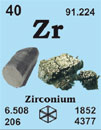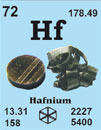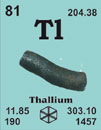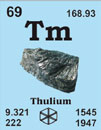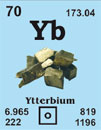Silicon 14Si28.086
Discovered in 1824 by J.J. Berzelius at Stockholm, Sweden.
[Latin, silicis = flint]
French: Silicium
German: Silizium
Italian: Silicio
Spanish: Silicio
Description: Black amorphous silicon is obtained by the reduction of sand (SiO2) with carbon. Ultrapure crystals if silicon have a blue-grey metallic sheen. Bulk silicon is unreactive towards oxygen, water and acids (exept HF), but dissolves in hot alkalis. Silicon is used in semiconductors, alloys and polymers.
Silicon single crystal properties
| State: |
single crystal |
|---|
| Crystal structure: |
diamond |
|---|
| Production method: |
Czochralski, Floating zone |
|---|
| Standard size: |
Diameter 20-80mm
thickness 1mm |
|---|
| Orientation: |
(110) and (111) |
|---|
| Orientation accuracy: |
<2°, <1°, <0.4° or <0.1° |
|---|
| Polishing: |
as cut, one or two sides polished |
|---|
| Roughness of surface: |
<0.03µm |
|---|
| Purity: |
99.999% |
|---|
| Typical analysis (ppm): |
C 3
H < 1
O 9
N < 5
Cu 1.60
Fe 1.80
Ni < 1
Pb 0.30
Si 0.30
Ga, Hf and Ta are below the detection limit
|
|---|
Materials properties
| Density: |
2.33 g/cm3 |
|---|
| Melting point: |
1409.85 °C / 1683 °K |
|---|
| Boiling point: |
2354.85 °C / 2628 °K |
|---|
| Molar volume: |
12.06 cm3 |
|---|
| Thermal conductivity: |
148 [300 K] Wm-1K-1 |
|---|
| Coefficient of linear thermal expansion: |
4.2 x 10-6 K-1 |
|---|
| Electrical resistivity: |
0.001x 10-8 [273 K] Wm |
|---|
| Mass magnetic susceptibility: |
-1.8 x 10-9(s) kg-1m3 |
|---|
| Young's modulus: |
113 GPa |
|---|
| Rigidity modulus: |
39.7 GPa |
|---|
| Bulk modulus: |
n.a. GPa |
|---|
| Poisson's ratio: |
0.05-0.42 |
|---|
| Radii: |
Si4+ 26; Si4- 271 atomic 117; covalent 117; van de |
|---|
| Electronegativity: |
1.90 (Pauling); 1.74 (Allred); 4.77 eV (absolute) |
|---|
| Effective nuclear charge: |
4.15 (Slater); 4.29 (Clementi); 4.48 (Froese-Fischer) |
|---|
| Number of Isotopes (incl. nuclear isomers): |
11 |
|---|
| Issotope mass range: |
24 -> 34 |
|---|
| Crystal structure, (cell dimentions / pm), space group |
diamond |
|---|
| X-ray diffraction: mass absorption coefficients: |
CuKα 60.6 (µ/r) / cm2g-1
MoKα 6.44 (µ/r) / cm2g-1 |
|---|
| Neutron scattering length: |
0.41543 b/10-12 cm |
|---|
| Thermal neutron capture cross-section: |
0.171 sa / barns |
|---|
Biological data
| Biological role: |
Silicon is essential to some species and possibly to humans. |
|---|
| Toxicity |
|
|---|
| Toxic intake: |
|
|---|
| Lethal intake: |
|
|---|
| Hazards: |
The fibres of some silicates, such as asbestos-type minerals, are carcinogenic. |
|---|
| Level in humans |
|
|---|
| Blood: |
3.9 mg dm-3 |
|---|
| Bone: |
17 p.p.m. |
|---|
| Liver: |
12 - 120 p.p.m. |
|---|
| Muscle: |
100 - 200 p.p.m. |
|---|
| Daily dietary intake: |
18 - 1200 mg |
|---|
| Total mass of element in average [70 kg] person: |
c. 1 g |
|---|
Geological data
| Mineral | Formula | Density | Hardness | Crystal apperance |
|---|
| Cristobalite |
SiO2 |
2.33 |
n.a. |
tet., vitreous/white |
|---|
| Opal |
SiO2.nH2O |
2 |
5.5 - 6.5 |
amor., transp./col./white |
|---|
| Quartz |
a-SiO2 |
2.655 |
7 |
rhom., vit., colourless |
|---|
| Tridymite |
SiO2 |
2.26 |
7 |
mon., vit., colourless/white |
|---|
| Chief ore: |
quartz (most common mineral on earth); also talc, mica. |
|---|
| World production: |
|
|---|
| Main mining areas: |
talc in Austria, Italy, India, South Africa, Australia; mica in Cananda, USA, India, Brazil |
|---|
| Reserves: |
unlimited |
|---|
| Specimen: |
available as powder, pieces or lumps. Safe. |
|---|
| Abundances |
|
|---|
| Sun: |
4.47 x 107(relative to H = 1 x 1012) |
|---|
| Earth's crust: |
277 100 p.p.m. |
|---|
| Seawater: |
|
|---|
| Residence time: |
|
|---|
| Classification: |
recycled |
|---|
| Oxidation state: |
IV |
|---|
Source: Emsley, J. (1998) The Elements (3rd Edition)

 English
English
 Deutsch
Deutsch








































